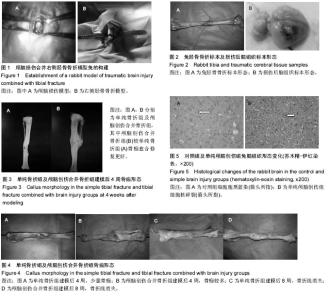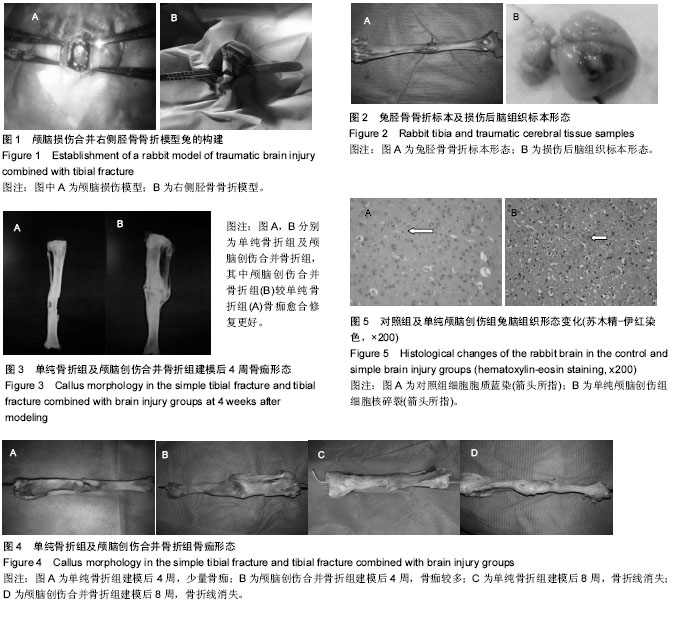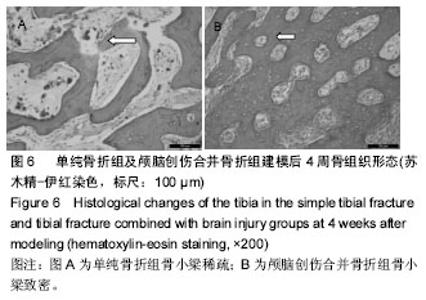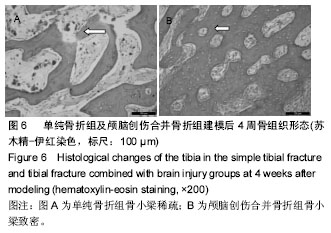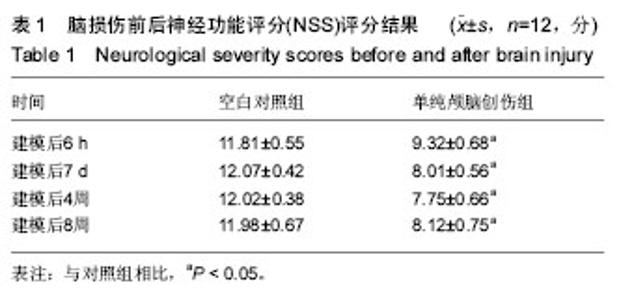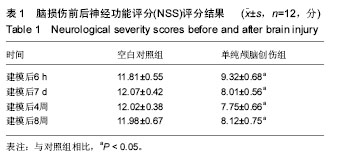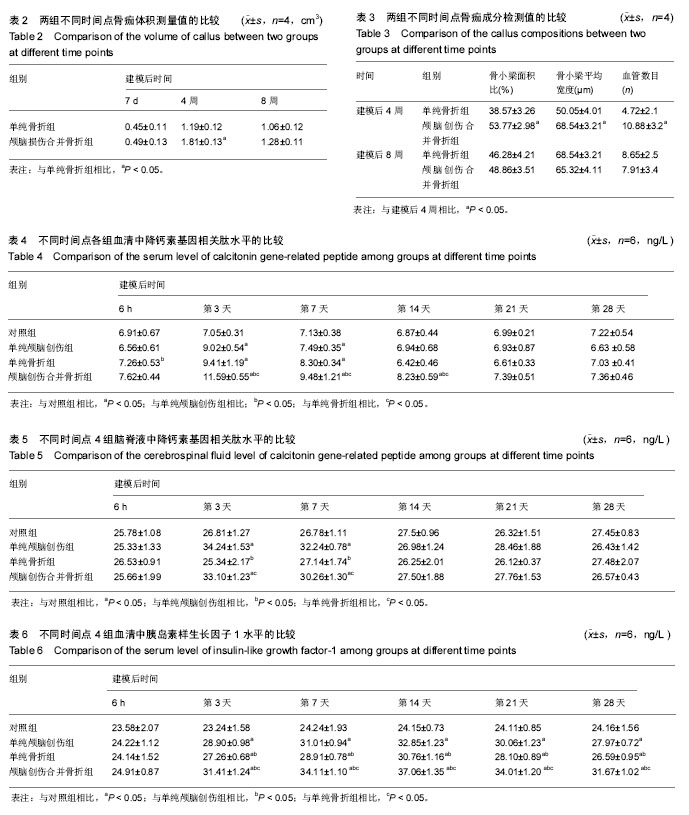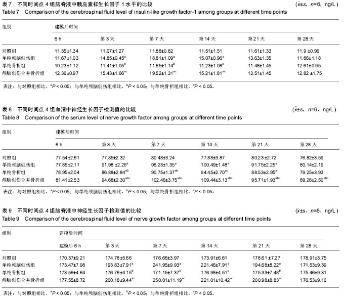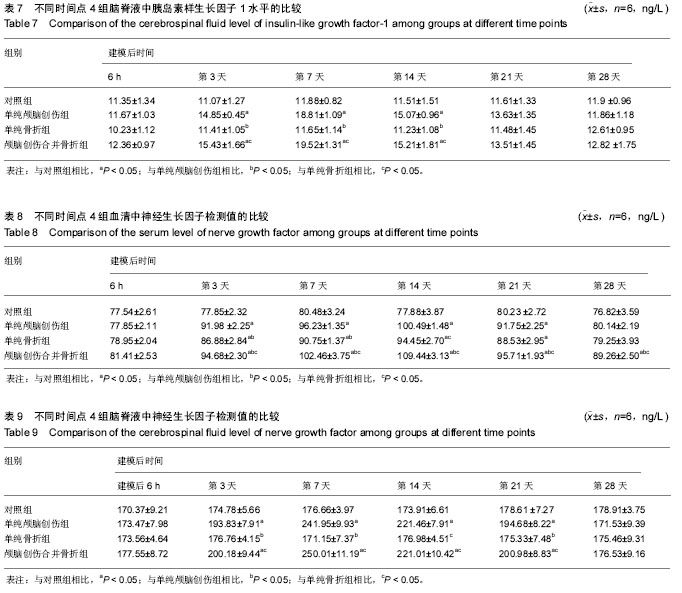| [1] Smith R. Head injury, fracture healing and callus. J Bone Joint Surg Br. 1987;69:518-520.[2] Spencer RF. The effect of head injury on fracture healing. A quantitative assessment. J Bone Joint Surg Br. 1987;69(4): 525-528.[3] Moore TJ. Functional outcome following surgical excision of heterotopic ossification in patients with traumatic brain injury. J Orthop Trauma. 1993;7:11-14.[4] Cadosch D. Functional and proteomic analysis of serum and cerebrospinal fluid derived from patients with traumatic brain injury: a pilot study. ANZ J Surg. 2010;80(7-8):542–547.[5] 徐婷,吴昆,顾星星,等.创伤性脑损伤后PHB2表达变化及其与星形胶质细胞增殖的相关性研究[J].中华神经医学杂志,2017, 16(7):671-675.[6] 吴精川,李辉,何骏驰,等.创伤性脑损伤后大鼠脑组织miRNA-9表达变化及意义[J].第三军医大学学报, 2017,39(14): 1458-1463.[7] 张胜利,谢玲霞,刘黎军,等.原癌基因c-fos和c-jun在创伤性脑损伤合并胫骨骨折大鼠中的表达[J].中华创伤骨科杂志,2017, 19(5):429-433.[8] 陈旭红,白露.创伤性脑损伤对骨折愈合影响动物模型的建立与评估[J].北京大学学报(医学版),2012,44(6):831-837.[9] 郑凯,于秀淳,郭征,等.新型β钛合金半针低弹性模量外固定系统对实验犬胫骨骨折愈合的影响[J].中华创伤骨科杂志,2014, 16(1):58-61.[10] 李立军,庞小建,朱福良,等.捆绑带束缚压力对兔胫骨骨折模型愈合影响的生物力学研究[J].中华临床医师杂志(电子版), 2014, 8(4):683-687.[11] 刘建军,韩庆斌,李新志,等.神经生长因子促进大鼠胫骨骨折愈合的实验研究[J].当代医学,2017,23(11):1-3.[12] 宋扬,韩一生,毕龙,等.创伤性脑损伤大鼠动物模型及其评价体系的建立[J].中华神经外科疾病研究杂志,2009,8(6):521-524.[13] 华峰,刘军,黄野,等.连续、无血污染的兔脑脊液的采集[J].南京医科大学学报(自然科学版),2008,28(2):263-264.[14] 杨子,赖关朝,王国彬,等.SD大鼠脑脊液采集方法改进[J].中国职业医学,2011,38(2):117-119. [15] 张升,辛艳飞,顾利强,等.Beagle犬脑脊液(CSF)多次采集手术模型的建立[J].实验动物科学,2011,28(5):69-71. [16] 吕田明,潘志勇.啮齿类动物脑脊液取样技术[J].中华临床医师杂志(电子版),2013,7(24):11623-11626.[17] 段丽君,姚梓平,朱红英,等.不同电针刺激强度对急性脑缺血再灌注大鼠NSS与脑组织含水量的影响[J].新疆医科大学学报, 2016, 39(11):1420-1423. [18] 张睿,杨祖悌,张同寅,等.异氟烷对创伤性脑损伤大鼠的神经保护作用及作用机制研究[J].实用心脑肺血管病杂志, 2015,23(8): 38-42. [19] 苏辉,戴宜武,邹德非,等.巴曲酶早期应用对大鼠脑创伤后神经功能恢复的促进作用[J].解放军医学院学报,2016,37(8):879-883. [20] 刘京敏,史晨辉,王维山,等.局部注射Neuritin促进骨折愈合的实验研究[J].石河子大学学报(自然科学版),2012,30(6):720-724. [21] 赵小纲,赵光锋,陈毅军,等.创伤性脑损伤影响骨折愈合速度的机制[J].中华急诊医学杂志,2007,16(9):936-939.[22] 张薇,李丽新.机械闭合性颅脑损伤实验动物模型的研究进展[J].德州学院学报,2009,25(4):107-110.[23] 于立明,张伟,陈坤,等.神经生长因子及其受体在下颌骨骨折愈合中的表达及意义[J].实用口腔医学杂志,2011,27(4):460-464.[24] 郭程亮,吴双芝,莱安平,等.神经生长因子联合组合式外固定架治疗骨不愈合的疗效观察[J].中国医药指南,2012,10(32):50-51.[25] 刘宇鹏,赵德伟,王卫明,等.神经生长因子对骨折愈合中骨形态发生蛋白表达的影响[J].中华医学杂志,2014,94(23):1825-1828.[26] 刘晓丹,李春风,谷大海,等.成骨细胞的研究进展[J].中国畜牧兽医,2011,38(7):53-58.[27] 孙嵩,高强国,张纲,等.神经生长因子调控降钙素基因相关肽的表达及对MG-63细胞增殖的影响[J].华西口腔医学杂志, 2015, 33(3):234-237. [28] 孙东良,陈通,付爱军,等.颅脑损伤合并股骨闭合性骨折大鼠模型的建立及骨痂中降钙素基因相关肽的表达及意义[J].中国煤炭工业医学杂志,2014,17(7):1123-1126.[29] Kaur G, Valarmathi MT, Potts JD, et al. Regulation of osteogenic differentiation of rat bone marrow stromal cells on 2D nanorod substrates. Biomaterials. 2010;31:1732-1741.[30] Yeni YN, Dong XN, Zhang B, et al. Cancellous bone properties and matrix content of TGF-beta2 and IGF-I in human tibia: a pilot study. Clin Orthop Relat Res. 2009;467: 3079-3086.[31] 贺军,林杨景,向登,等.血清胰岛素样生长因子1在骨折合并脑损伤患者血清中的表达及其意义[J].中国医药,2014,9(11): 1656-1660. |
